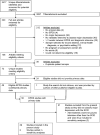Depression prevalence based on the Edinburgh Postnatal Depression Scale compared to Structured Clinical Interview for DSM DIsorders classification: Systematic review and individual participant data meta-analysis
- PMID: 33089942
- PMCID: PMC7992289
- DOI: 10.1002/mpr.1860
Depression prevalence based on the Edinburgh Postnatal Depression Scale compared to Structured Clinical Interview for DSM DIsorders classification: Systematic review and individual participant data meta-analysis
Abstract
Objectives: Estimates of depression prevalence in pregnancy and postpartum are based on the Edinburgh Postnatal Depression Scale (EPDS) more than on any other method. We aimed to determine if any EPDS cutoff can accurately and consistently estimate depression prevalence in individual studies.
Methods: We analyzed datasets that compared EPDS scores to Structured Clinical Interview for DSM (SCID) major depression status. Random-effects meta-analysis was used to compare prevalence with EPDS cutoffs versus the SCID.
Results: Seven thousand three hundred and fifteen participants (1017 SCID major depression) from 29 primary studies were included. For EPDS cutoffs used to estimate prevalence in recent studies (≥9 to ≥14), pooled prevalence estimates ranged from 27.8% (95% CI: 22.0%-34.5%) for EPDS ≥ 9 to 9.0% (95% CI: 6.8%-11.9%) for EPDS ≥ 14; pooled SCID major depression prevalence was 9.0% (95% CI: 6.5%-12.3%). EPDS ≥14 provided pooled prevalence closest to SCID-based prevalence but differed from SCID prevalence in individual studies by a mean absolute difference of 5.1% (95% prediction interval: -13.7%, 12.3%).
Conclusion: EPDS ≥14 approximated SCID-based prevalence overall, but considerable heterogeneity in individual studies is a barrier to using it for prevalence estimation.
Keywords: Edinburgh Postnatal Depression Scale; depression prevalence; individual participant data meta-analysis; major depression; structured clinical interview for DSM.
© 2020 The Authors. International Journal of Methods in Psychiatric Research published by John Wiley & Sons Ltd.
Conflict of interest statement
All authors have completed the ICJME uniform disclosure form and declare: no support from any organization for the submitted work;
Anita Lyubenova, Dipika Neupane, Brooke Levis, Yin Wu, Jill T. Boruff, John P. A. Ioannidis, Pim Cuijpers, Simon Gilbody, Lorie A. Kloda, Scott B. Patten, Ian Shrier, Roy C. Ziegelstein, Liane Comeau, Nicholas D. Mitchell, Marcello Tonelli, Simone N. Vigod, Andrea Benedetti, and Brett D. Thombs were responsible for the study conception and design. Jill T. Boruff and Lorie A. Kloda designed and conducted database searches to identify eligible studies. Franca Aceti, Jacqueline Barnes, Amar D. Bavle, Cheryl T. Beck, Carola Bindt, Philip M. Boyce, Andrea Bunevicius, Linda H. Chaudron, Nicolas Favez, Barbara Figueiredo, Lluïsa Garcia‐Esteve, Lisa Giardinelli, Nadine Helle, Louise M. Howard, Jane Kohlhoff, Laima Kusminskas, Zoltán Kozinszky, Lorenzo Lelli, Angeliki A. Leonardou, Valentina Meuti, Sandra N. Radoš, Purificación N. García, Susan J. Pawlby, Chantal Quispel, Emma Robertson‐Blackmore, Tamsen J. Rochat, Deborah J. Sharp, Bonnie W. M. Siu, Alan Stein, Robert C. Stewart, Meri Tadinac, S. Darius Tandon, Iva Tendais, Annamária Töreki, Anna Torres‐Giménez, Thach D. Tran, Kylee Trevillion, Katherine Turner, Johann M. Vega‐Dienstmaier were responsible for collection of primary data included in this study. Anita Lyubenova, Dipika Neupane, Brooke Levis, Ying Sun, Chen He, Ankur Krishnan, Parash M. Bhandari, Zelalem Negeri, Mahrukh Imran, Danielle B. Rice, Marleine Azar, Matthew J. Chiovitti, Nazanin Saadat, Kira E. Riehm, and Brett D. Thombs contributed to the title and abstract and full‐text review processes and data extraction for the meta‐analysis. Anita Lyubenova, Dipika Neupane, Brooke Levis, Yin Wu, Andrea Benedetti, and Brett D. Thombs contributed to the data analysis and interpretation. Anita Lyubenova, Dipika Neupane, Brooke Levis, Yin Wu, Andrea Benedetti, and Brett D. Thombs contributed to drafting the manuscript. All authors provided a critical review and approved the final manuscript. Andrea Benedetti and Brett D. Thombs are guarantors.
Figures



References
-
- Aceti, F. , Aveni, F. , Baglioni, V. , Carluccio, G. M. , Colosimo, D. , Giacchetti, N. , … Biondi, M. (2012). Perinatal and postpartum depression: From attachment to personality. A pilot study. Journal of Psychopathology, 18, 328–334.
-
- American Psychiatric Association . (1987). Diagnostic and statistical manual of mental disorders: DSM‐III (3rd ed., revised). Washington, DC:American Psychiatric Association.
-
- American Psychiatric Association . (1994). Diagnostic and statistical manual of mental disorders: DSM‐IV (4th ed.). Washington, DC: American Psychiatric Association.
-
- American Psychiatric Association . (2000). Diagnostic and statistical manual of mental disorders: DSM‐IV (4th ed., text revised). Washington, DC:American Psychiatric Association.
-
- American Psychiatric Association . (2013). Diagnostic and statistical manual of mental disorders (5th ed.). Washington, DC: American Psychiatric Association.

